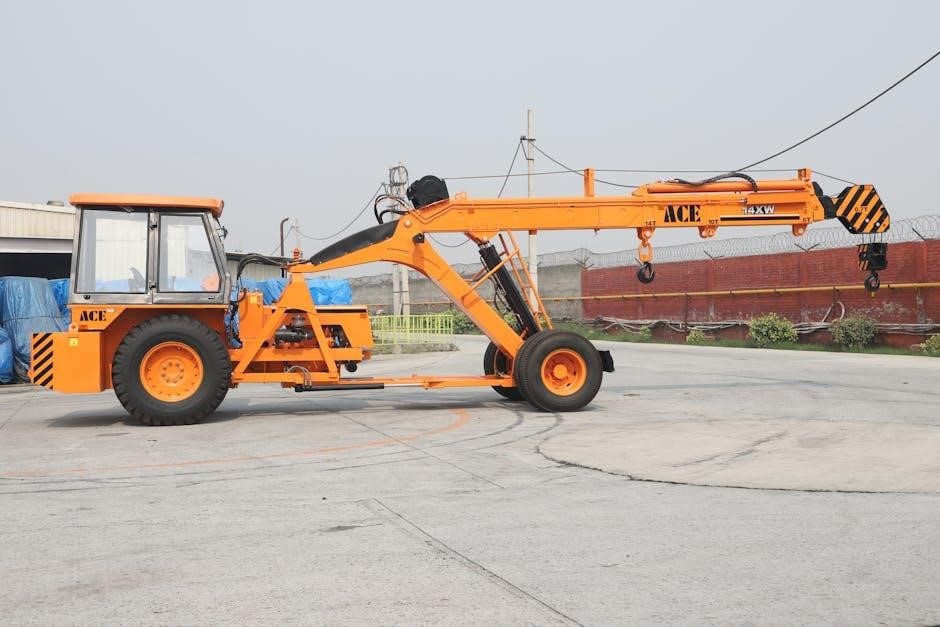The Automotive Lift Institute’s (ALI) Vehicle Lifting Points Guide provides essential information for safely raising vehicles using OEM-recommended lifting points, covering models from 2000 onward.
What Are Vehicle Lifting Points?
Vehicle lifting points are specific locations on a vehicle’s frame designed for safe lifting using jack stands or hydraulic lifts. These points distribute the weight evenly, preventing damage to the vehicle. They are manufacturer-recommended and vary by make and model. The ALI Lifting Points Guide provides detailed diagrams and instructions for locating these points on domestic and imported cars, SUVs, trucks, and EVs from 2000 onward. Using correct lifting points ensures safety and prevents structural damage during maintenance or repairs.
Importance of Using Correct Lifting Points
Using correct lifting points is crucial for safety, preventing vehicle damage, and ensuring stability during maintenance or repairs. Incorrect lifting can cause structural damage or collapse, risking injury and costly repairs. Manufacturer-recommended points distribute weight evenly, maintaining the vehicle’s integrity. Adhering to these guidelines ensures safe lifting, protects the vehicle, and avoids potential hazards. This practice is essential for technicians and home mechanics to guarantee reliable and secure lifting every time.

Types of Vehicle Lifting Points
Vehicle lifting points include frame-engaging and axle-based designs, each located at specific manufacturer-recommended positions to ensure safe and stable lifting for various vehicle types and models.
OEM-Recommended Lifting Points
OEM-recommended lifting points are specifically designed by vehicle manufacturers for safe lifting. They ensure stability and prevent damage to the vehicle’s frame or undercarriage. These points are typically marked in the vehicle’s service manual or the ALI Lifting Points Guide. Proper use of these points guarantees secure contact and even weight distribution, reducing risks during maintenance or repairs. Always refer to manufacturer guidelines to locate and use these designated areas correctly for optimal safety and effectiveness.
Aftermarket Lifting Points
Aftermarket lifting points are alternative solutions designed for vehicles where OEM points are unclear or inaccessible. They offer versatility for various lift types but must be installed and used with caution. Ensure compatibility with your vehicle’s make and model, and always follow manufacturer instructions. While convenient, aftermarket points should not replace OEM recommendations. Proper installation and alignment are crucial to maintain safety and avoid potential damage during lifting operations.
Frame-Engaging vs. Axle-Based Lifting Points
Frame-engaging lifting points attach directly to the vehicle’s chassis, distributing weight evenly and maintaining stability. Axle-based points, while quicker to position, focus on axle components. The ALI guide distinguishes between these methods, emphasizing frame-engaging lifts for accuracy and safety. Always refer to the guide for proper identification and usage, ensuring secure contact and optimal load distribution based on vehicle type and manufacturer specifications. This distinction ensures safe and effective lifting operations for various vehicle models.

Locating Vehicle Lifting Points
Lifting points are typically found in the vehicle’s service manual or the ALI Lifting Points Guide; They are often located near the front wheel wells and behind the rear wheels for most cars, SUVs, and trucks, ensuring safe and stable lifting operations.
How to Identify Lifting Points on Your Vehicle
To identify lifting points, refer to your vehicle’s service manual or the ALI Lifting Points Guide. Look for metal reinforcements near the wheel wells or along the frame. These points are often marked with bolted brackets or specific notches. Ensure the lifting arms align with these reinforced areas to maintain stability. Always double-check the guide for accurate diagrams, as locations vary by vehicle make and model. This ensures safe and proper lifting practices for any maintenance or repair task.
Using Vehicle Manuals and Manufacturer Guides
Consult your vehicle’s service manual for detailed diagrams and instructions on locating lifting points. Manufacturer guides provide precise information on recommended lifting areas, ensuring safety and preventing damage. Cross-reference with the ALI Lifting Points Guide for additional clarity, especially for vehicles with unmarked points. Always follow these guidelines to avoid improper lifting, which can lead to structural damage or unsafe conditions during maintenance and repairs.
Role of the ALI Lifting Points Guide
The Automotive Lift Institute’s (ALI) Lifting Points Guide serves as a comprehensive resource, providing OEM-recommended lifting points for vehicles from 2000 onward. It includes diagrams and specifications for domestic and imported cars, SUVs, trucks, and EVs. This guide ensures technicians and home mechanics can safely and accurately position lift arms, reducing risks of damage or injury. Its digital PDF format offers easy access, making it an indispensable tool for proper vehicle lifting procedures and compliance with safety standards.

Safety Tips for Vehicle Lifting
Always perform pre-lift checks, ensure vehicle stability, and position lift arms correctly. Refer to manufacturer manuals for load-bearing capacities and recommended lifting points to avoid accidents.
Pre-Lift Safety Checks
Before lifting, inspect the vehicle for damage. Ensure the area is clear of obstructions. Check lifting equipment for proper function. Position jack stands for added support. Verify the vehicle’s weight and recommended lifting points. Always refer to the manufacturer’s guide to avoid overloaded lifts. Stability is crucial to prevent accidents during the lifting process. A thorough pre-lift inspection ensures a safer environment for both the technician and the vehicle.
Stability and Load-Bearing Considerations
Stability is critical when lifting a vehicle. Ensure the lift is on a level surface and the vehicle is centered. Load-bearing capacity must not be exceeded. Use jack stands for added support. The weight distribution should align with manufacturer guidelines to prevent instability. Properly engaging lifting points ensures even load distribution, reducing the risk of equipment failure. Always follow the ALI Lifting Points Guide for accurate load-bearing specifications and stability checks to maintain safety during the lifting process.

ALI Lifting Points Guide Overview
The ALI Lifting Points Guide provides detailed diagrams and OEM-recommended lifting points for vehicles from 2000 onward, ensuring safe and accurate lifting practices for technicians and mechanics.
Features of the Digital PDF Guide
The digital PDF guide offers searchable content, zoomable diagrams, and cross-referenced data for quick access. It covers over 20 years of vehicle models, including EVs, with detailed OEM specifications. The guide is optimized for mobile devices, allowing technicians to access information on-site. Regular updates ensure compatibility with the latest models. This comprehensive resource enhances efficiency and accuracy in vehicle lifting, making it indispensable for professionals and home mechanics alike.
Coverage of Vehicle Models (2000 and Later)
The guide covers domestic and imported cars, SUVs, light-duty trucks, and EVs from 2000 onward. It includes detailed diagrams and specifications for various models, ensuring compatibility with modern and older vehicles. This extensive coverage makes it a versatile tool for technicians and home mechanics, addressing the diverse needs of the automotive industry with precise and updated information for safe lifting practices across different vehicle types and years.
Benefits for Technicians and Home Mechanics
The guide offers technicians and home mechanics precise OEM-recommended lifting points, reducing guesswork and enhancing safety. It streamlines workflows, saving time and minimizing risks of damage or injury. Regular updates ensure compliance with the latest vehicle designs, making it an indispensable resource for professionals and DIY enthusiasts alike, fostering confidence and efficiency in every lifting task.

Vehicle-Specific Lifting Considerations
The guide provides detailed lifting points for domestic, imported cars, SUVs, trucks, and EVs, ensuring safe and efficient lifting based on each vehicle’s unique design and specifications.
Domestic and Imported Cars, SUVs, and Trucks

The ALI Lifting Points Guide covers a wide range of domestic and imported vehicles, including cars, SUVs, and trucks. It provides detailed diagrams and specifications for safe lifting, ensuring compatibility with various frame designs and manufacturer recommendations. This comprehensive resource helps technicians and home mechanics identify correct lifting points, reducing risks of damage or instability during maintenance or repairs. Regular updates ensure the guide stays current with new models and evolving vehicle designs.
Special Considerations for Electric Vehicles (EVs)
Electric vehicles (EVs) require unique attention when lifting due to their distinct weight distribution and battery placement. The ALI Lifting Points Guide addresses these specifics, ensuring safe handling of EVs without compromising their advanced systems. It highlights manufacturer-recommended points to avoid damage to high-voltage components and provides updated diagrams for models like Tesla, Ford, and Chevrolet. This focus on EVs makes the guide indispensable for modern technicians adapting to the electric revolution in automotive maintenance.

Using the Guide for Proper Lifting
The ALI guide provides clear instructions for positioning lift arms at OEM-recommended points, ensuring secure contact and safe lifting practices for vehicles, including EVs and trucks.
Step-by-Step Guide to Positioning Lift Arms
Start by referencing the ALI guide to locate the vehicle’s recommended lifting points using detailed diagrams. Position lift arms at these points, ensuring secure contact with the vehicle’s frame. Raise the lift gradually, checking for stability and proper load distribution. Verify that the arms are fully engaged and not slipping. Always refer to the guide for vehicle-specific instructions, especially for EVs or modified vehicles. Use the digital PDF for quick access and precise positioning.
Ensuring Secure Contact with Lifting Points
For secure contact, align lift arms precisely with the vehicle’s recommended lifting points as indicated in the ALI guide. Ensure arms are free from obstructions and debris. Use adapters if necessary to prevent slippage. Apply minimal upward force to test stability before full lifting. Regularly inspect lift equipment for wear and tear. Proper engagement prevents vehicle damage and ensures safety, especially for heavy or specialized vehicles like EVs or trucks. Always refer to the guide for vehicle-specific adjustments.

Common Mistakes to Avoid
Avoid positioning lift arms incorrectly and ignoring manufacturer recommendations, as this can lead to vehicle instability and potential damage, emphasizing the need for adherence to guidelines.
Incorrect Positioning of Lifting Arms
Incorrectly positioning lifting arms can lead to unstable vehicle support, potentially causing damage or accidents. Always refer to the ALI Lifting Points Guide to ensure arms are placed at OEM-recommended locations. Misalignment can shift the vehicle’s weight unevenly, risking slippage or frame damage. Proper positioning ensures even load distribution and maintains safety during lifting. Neglecting manufacturer guidelines increases risks, especially for vehicles with altered weight distributions, such as those missing heavy components like engines or transmissions.
Ignoring Manufacturer Recommendations
Ignoring manufacturer recommendations for lifting points can lead to unsafe lifting practices, potentially causing vehicle damage or accidents. Always consult the vehicle’s service manual or the ALI Lifting Points Guide for accurate information. Misaligned lifting arms or incorrect load-bearing points can compromise stability, especially for vehicles with unique weight distributions, such as electric vehicles or those with heavy components removed. Adhering to OEM guidelines ensures secure and stable lifting, preventing potential risks to both the vehicle and the technician.
The Vehicle Lifting Points Guide by ALI ensures safe and effective lifting practices, providing essential OEM-recommended points for technicians and home mechanics to follow for optimal safety and efficiency.
Final Thoughts on Safe and Effective Vehicle Lifting
Adhering to OEM-recommended lifting points ensures vehicle stability and safety during lifts. The ALI guide provides clear diagrams and instructions for accurate lift arm placement, covering domestic, imported, and EV models. Ignoring these guidelines risks damage or accidents. Regularly consulting the guide is essential for technicians and home mechanics to maintain safety and efficiency in every lifting operation. Always prioritize manufacturer recommendations for secure and effective vehicle lifting practices.